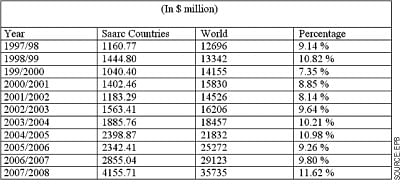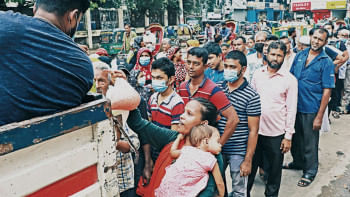Regional trade and economic cooperation in South Asia

GLOBALISATION has made international trade very competitive. The World Trade Organization (WTO) member countries are facing various barriers to trade promotion. Due to the time-consuming process of removing the barriers, many countries are now thinking of alternatives like regional and bilateral free trade agreements for duty-free market access for many of their products.
The European Union (EU), considered a model of regional integration, has emerged as an economic power. It acts as a unit in various international bodies like the UN and the WTO.
Keeping this in mind, South Asian leaders formed South Asian Association for Regional Cooperation (Saarc) and adopted South Asian Preferential Trading Arrangement (Sapta) and South Asian Free Trade Agreement (Safta). Safta came into effect on January 1, 2006, but South Asia is miles from the cherished goal of free trade.
Bangladesh needs to assess whether or not Safta will increase trade. It should study the barriers its businessmen are facing in doing business with the other Saarc countries to pinpoint the measures to make Safta more effective.
The study should concentrate on analysing the possible impact Safta could have on Bangladesh's trade with the other Saarc countries. It should identify Bangladesh's major exportable products in the negative or sensitive list of the Saarc countries, so that it can take up the issue in the next trade negotiations under Safta.
Bangladesh should identify major barriers to intra-Saarc trade. It should take up the issue of making Safta an effective regional trade arrangement by removing the problems.
Bangladesh's trade with Saarc countries: See Figure 1.
Bangladesh's trade with Saarc countries is rising slowly, but trade under Safta has not risen as it should have. However, trade with rest of the world has risen sharply. This means that Safta has brought no significant benefit for Bangladesh trade.
Bangladesh exports to, and imports from Saarc countries: See Figure 2.
While Bangladesh's imports from Saarc countries increased significantly after Safta was activated, its exports have not increased accordingly.
Comparison between Bangladesh's export to Saarc countries and the world, before and after Safta was activated: See Figure 3.
Under the Safta arrangement, every member-country retains the right to protect its industry by imposing restrictions on imports. The list of restricted products is known as the sensitive list of negative items. The big negative list under Safta calls for careful study and review.
The following are the major exportable products of Bangladesh in the negative list of the other Saarc countries under the Safta regime:
-Woven Garments HS Code 5208.11.00 5911.40.00
-Knitwear HS Code 6101.20.00 6310.90.00
-Lather Goods & Footwear HS Code 4107.11.00 6406.99.00
-Ceramic Products HS Code 6901.00.00 6914.90.00
-Jute & Jute Goods HS Code 5601.10.10 5705.00.90
-Tea HS Code 0902.10.00 0902.40.00
-Handicrafts HS Code - 4202.11.00
-Calendars HS Code 4910.00.00
-Bicycles HS Code 8714.11.00 8714.99.00
-Pharmaceuticals Products HS Code 3001.20.00 3006.92.00
-Meat HS Code 0201.10.10 0210.99.20
-Vegetables HS Code 0601.10.00 0801.11.00
-Ships (Finished Vessels) HS Code 8901.10.10 8908.00.90
Afghanistan listed 18 major exportable products of Bangladesh in its negative list under the Safta regime. They include RMG, ceramics and handicrafts etc.
The negative list of Pakistan contains 39 major exportable products of Bangladesh. They include RMG, green tea, light engineering products, bicycles etc.
The negative list of India contains 27 major exportable products of Bangladesh. They include RMG, textile materials, footwear, meat, sports item, ceramic and tiles etc.
The negative list of Nepal contains 49 major exportable products of Bangladesh. They include RMG, textile, tea, ceramic and tiles etc.
The negative list of Bhutan contains six major exportable products of Bangladesh. They include RMG, textile, and green tea.
The negative list of Sri Lanka contains 53 major exportable products of Bangladesh. They include meat, tea, textile, ceramics and RMG.
The negative list of the Maldives contains 12 major exportable products of Bangladesh. They include fishing vessels, RMG, tea and jute products.
The other Saarc countries use very high rates of tariff structure as tariff barriers to obstruct imports.
There are also non-tariff barriers to trade in the Saarc region. These include:
-Lack of trust;
-Lack of land connectivity;
-Transit Crisis;
-Lack of inter-border transportation entrance;
-Complicated visa system;
-Political conflict;
-Lack of ICT support and
-Large negative list.
However, Safta can be more effective if the agreements thereof are properly implemented, tariffs are reduced for intra-Saarc trade, non-tariff barriers are removed, the negative lists are shortened and the private sector representatives are involved in the negotiations.
A Saarc task force does need to identify the problems for taking remedial actions. If a coordinated common economic approach is taken and a regional fund is created to promote poverty reduction, economic cooperation among the member-countries of the Saarc can be strengthened.

 For all latest news, follow The Daily Star's Google News channel.
For all latest news, follow The Daily Star's Google News channel. 



Comments